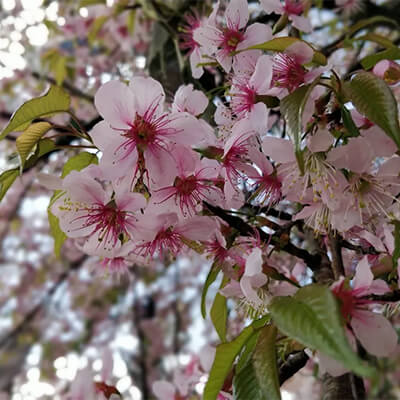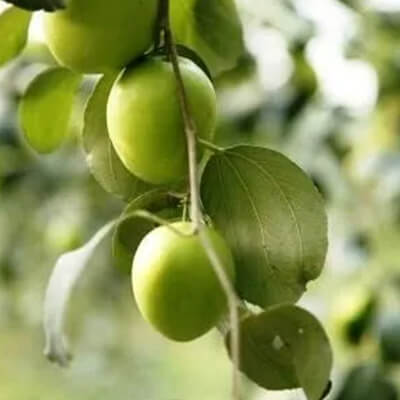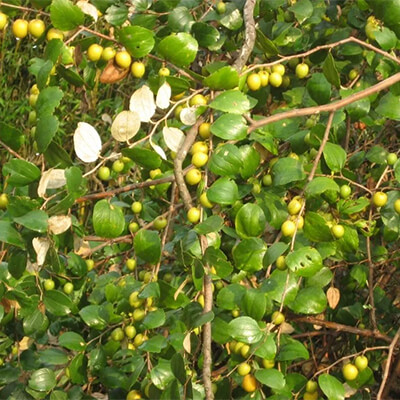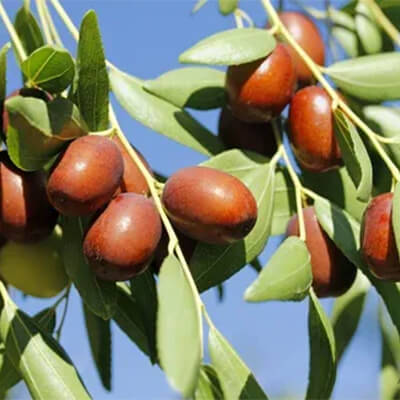On This Page
Padmaka (Prunus cerasoides) – A Himalayan Cherry
Introduction
Himalayan Cherry, botanically known as Prunus cerasoides, is a drug that has significant therapeutic and ethnobotanical importance. Its fruits are important as the edible item in the traditional diet of the local population. Padmaka is considered an excellent framework tree for restoring the evergreen forest. In Hindu mythology, Padmakastha is considered a sacred plant. Padmaka’s geographical distribution is restricted from sub-montane to montane Himalaya. It has been used in various Ayurvedic formulations and along with this its efficacy is fully recognized by modern science by various research. It consists of various active ingredients like steroids, polyphenols, etc due to which it revealed anti-diuretic, anti-microbial, antioxidant, etc activities. As per Ayurvedic classical literature, Padmaka is chiefly a Vedna Sthapak i.e analgesic herbal agent, with cold potency and astringent bitter.
Basonym of Padmaka
पद्ममिव वर्णगन्धे च।
पद्ममिव पुष्पमस्तयस्याः। पद्म सदृशं पुष्प वर्णं वा।।
The flowers of Padmaka is resembling with the flower of Padam (Nelumbo nucifera) and even the aroma is similar to it.
Synonyms of Padmaka
- According to habitat
हिमपद्मकं – हिमजल परदेशो जातं।
Padmaka plant grows in the Himalayas region.
- According to morphology
चारु – सुन्दरो वृक्षाः।
The Padmaka plant is very attractive.
पद्म काष्ठं – पद्ममिव वर्णे गन्धे च काष्ठंस्या।
The color and odor of the Padmaka stem are similar to the lotus.
- According to properties and action
शीत वीर्याः – शीत वीर्य मस्याः।
Padmaka has cold potency.
Some Other Synonyms of Padmaka:
- Kedaraja: Padmaka grows in the Himalaya region.
- Maru Udhbhava: It grows in the dry mountains.
- Surabhi: Its part used is wood and it is fragrant.
- Padmaka, Padmkastha, Padmgandhi: Padmaka has an aroma like the lotus flower.
- Pita- Rakta: In color, it is yellow-red.
- Padma Varnaka, Patala Pushpa Varnaka: Its flower resembles the flower of the lotus or Patala.
Regional Name of Padmaka
- Padmakh, Padmakath (Hindi)
- Paiyan (Kumaon, U.P)
- Padmak (Marathi, Gujarati)
- Dieng – soh – iong – kerm (Assamese)
- Padma Kashtam (Telugu)
- Padmaka (Kannada)
- Patumukam (Malayalam)
- Paja, Chabheearee, Amalguckr (Punjabi)
- Bird cherry, Himalayan wild cherry (English)
Botanical Name
Prunus cerasoides Linn.
Prunus word means frosted, snowy
Cerasoides means that resembles “cerasus”
Family
Rosaceae (Taruni Kula “Rose family”)
Ayurveda Reference for Padmaka (Prunus cerasoides)
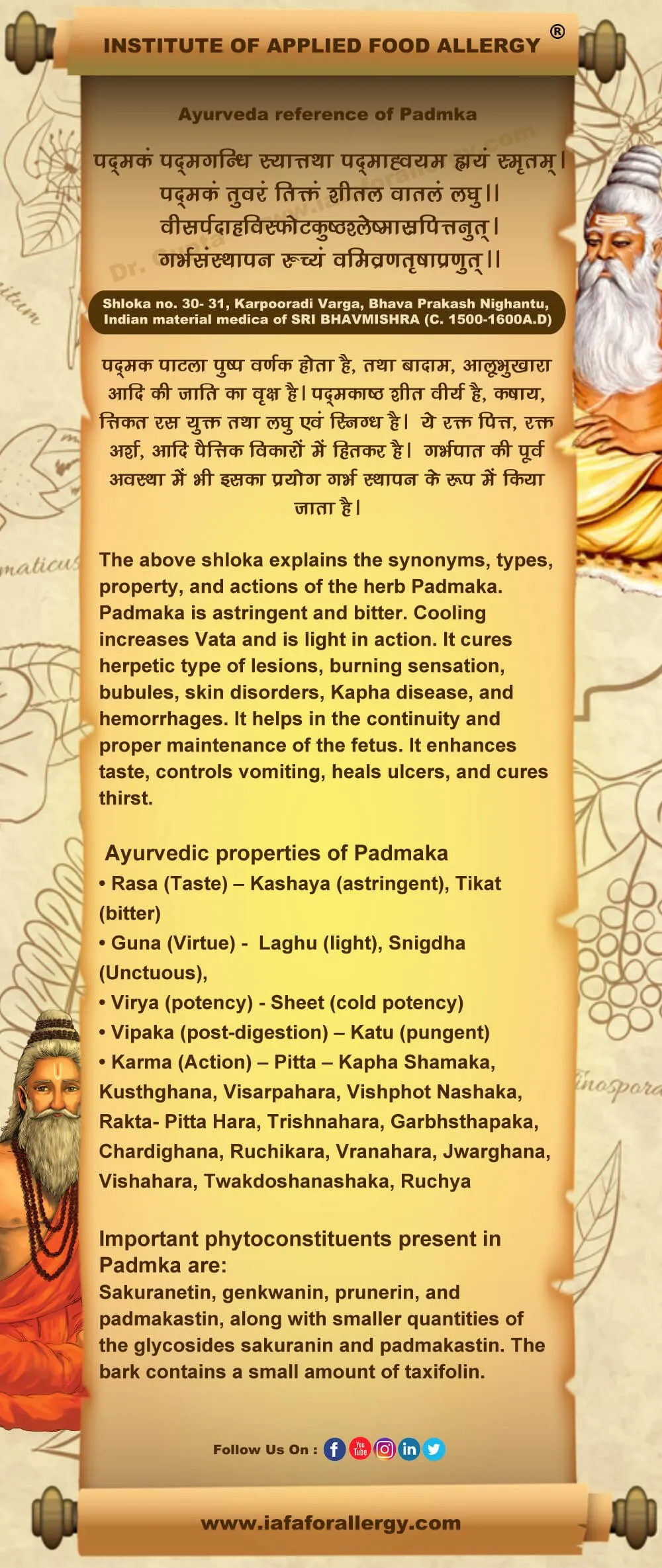
Scientific Classification of Padmaka
| Kingdom | Plantae |
| Class | Dicotyledons |
| Subclass | Polypetalae |
| Series | Calyciflorae |
| Order | Rosales |
| Family | Rosaceae |
| Genus | Prunus |
| Species | cerasoides |
Classification of Padmaka as per Charaka and Sushruta
- Charaka: Varnya Mahakshaya, Vedna Sthapana Mahakshaya, Kashaya Skandha
- Sushruta: Sarivadi Gana, Chandanadi Gana
Padmaka Description in Brihtrayi
| Charaka | Shusruta | Vagbhata (Ashtang Hridya) |
| C. S. Su. 3/ 23, 26 | S. S. Su. 38/ 34, 38. 49 | A. H. Su. 7/ 19 |
| C. S. Su. 4/ 8, 47 | S. S. Chi. 2/ 38, 40, 68, 75, 82 | A. H. Su. 15/ 6 |
| C. S. Vi. 8/ 151 | S. S. Chi. 5/ 8, 10, 12 | A. H. Su. 16/17 |
| C. S. Chi. 3/ 257 | S. S. Chi. 8/ 444 | A. H. Su. 19/ 57 |
| C. S. Chi. 4/ 67, 73 | S. S. Chi. 9/ 8, 50 | A. H. Su. 21/ 17 |
| C. S. Chi. 6/ 30, 38 | S. S. Chi. 16/ 14 | A. H. Su. 22/ 20 |
| C. S. Chi. 7/ 68, 131, 145 | S. S. Chi. 17/ 8, 10 | A. H. Su. 27/ 49 |
| C. S. Chi. 8/ 82 | S. S. Chi. 19/ 30 | A. H. Chi. 1/ 56 |
| C. S. Chi. 9/ 44 | S. S. Chi. 22/ 12 | A. H. Chi. 2/ 27 |
| C. S. Chi. 11/ 31 | S. S. Chi. 25/ 16, 39 | A. H. Chi. 3/ 10, 90, 172 |
| C. S. Chi. 12/ 64, 67, 68 | S. S. Chi. 37/ 27 | A. H. Chi. 4/ 14 |
| C. S. Chi. 14/ 216 | S. S. Chi. 38/ 52, 54, 56 | A. H. Chi. 5/ 70 |
| C. S. Chi. 15/ 126, 138 | S. S. Ka. 5/ 68 | A. H. Chi. 8/ 113 |
| C. S. Chi. 17/ 80, 145 | S. S. Ka. 6/ 8, 15 | A. H. Chi. 10/ 35, 41 |
| C. S. Chi. 18/ 88, 172, 174, 176 | S. S. Ka. 8/ 49, 106, 108, 112, 114, 119 | A. H. Chi. 12/ 18 |
| C. S. Chi. 21/ 73, 86 | S. S. U. 10/ 4 | A. H. Chi. 13/ 4 |
| C. S. Chi. 23/ 200, 242 | S. S. U. 12/ 7 | A. H. Chi. 14/ 66 |
| C. S. Chi. 26/ 207, 215, 232 | S. S. U. 17/ 90, 93 | A. H. Chi. 17/ 22 |
| C. S. Chi. 27/ 30 | S. S. U. 26/ 14 | A. H. Chi. 18/ 14 |
| C. S. Chi. 28/ 150 | S. S. U. 30/ 4 | A. H. Chi. 19/ 8, 33 |
| C. S. Chi. 29/ 65, 93, 110, 112, 114, 134, 146 | S. S. U. 39/ 180, 242, 305 | A. H. Chi. 21/ 76 |
| C. S. Si. 3/ 46 | S. S. U. 40/ 121 | A. H. Chi. 22/ 29, 43 |
| C. S. Si. 10/ 20 | S. S. U. 45/ 30 | A. H. Ka. 4/ 12 |
| S. S. U. 47/ 31, 41 | A. H. U. 2/ 15, 50 | |
| S. S. U. 51/ 51 | A. H. U. 5/ 19 | |
| S. S. U. 52/ 14 | A. H. U. 6/ 28 | |
| S. S. U. 62/ 28 | A. H. U. 13/ 65, 74 | |
| A. H. U. 14/ 28 | ||
| A. H. U. 16/ 4 | ||
| A. H. U. 22/ 80, 85, 93 | ||
| A. H. U. 25/ 47, 65 | ||
| A. H. U. 26/ 26, 55 | ||
| A. H. U. 27/ 39 | ||
| A. H. U. 28/ 35 | ||
| A. H. U. 32/ 27, 32 | ||
| A. H. U. 36/ 63, 79 | ||
| A. H. U. 37/ 70, 82, 86 |
External Morphology of Prunus cerasoides (Padmaka)
Habitat: A handsome medium-sized tree, with glossy green leaves, nearly glabrous, and pale redwood.
Leaves: Leaves ovate, simple, alternate, glossy, long-acuminate, sharply and often duplicate-serrate, 3-5 in. long. Petioles, 1/3 inch with 2-4 large glands, near the base of the leaf. Stipules palmately 3-5-fid, the divisions lanceolate, glandular imbricate.
Bark: Bark of prunus is brown in color with smooth surface. Bark on peeling, peels off in horizontal strips as a result of which a shining copper-colored surface is exposed.
Flowers: Flowers white or pink, appearing before the leaves, on slender pedicels as long as flowers, or somewhat longer, often branched, in umbellate fascicles crowded near the ends of branches. Calyx turbinate with ovate-acute lobes, drupe ovoid or globose, 1/2-3/4 in. long, acid and somewhat astringent when ripe, kernel ovoid, rugose and furrowed.
Fruits: Fruits are ovoid or globose drupes, yellow to red.
Seed: Seed ovoid, rugose, and furrowed.
Flowering and fruiting time
Padmaka flowers come from October to December to April-May and onwards it bears fruits.
Controversy
Padmka is interpreted as Padma Prapaundrika. It is also considered with Elavaluka. So far, padmaka is universally accepted as Prunus cerasoides Linn.
Distribution of Padmaka
Globally it is distributed in Pakistan, Nepal, Bhutan, and Myanmar. Padmaka occurs in the temperate regions from Indus to Bhutan and it is fairly common in the Himalayan regions, especially in the outer region.
In India, it is distributed in Uttranchal, Sikkim, and Meghalaya and also in Nilgiris of Tamilnadu. In India, Garhwal hill is distributed in the temperate zone of Tehari, Paouri, Chamoli, and Uttarkashi districts.
The Useful Part of Padmaka
Bark and Seed pulp (kernel)
Nutritional Value of Padmaka
| Nutrients | Value/ 100g |
| Protein (g) | 1.06 g |
| Fat | 0.04 g |
| Fiber | 2.1 g |
Important Phytoconstituent of Padmaka
- Stem- bark: Stem bark contains flavanone – 1% sakuranetin, flavone- genkwanin, Isoflavone – prunerin, and isoflavone – padmakastin, along with smaller quantities of the glycosides sakuranin and padmakastin. Bark exudes gum-resin abundantly.
- Bark: Bark contains a small amount of taxifolin.
- Sapwood: Urosolic acid, oleic acid
Recent Research on Padmaka
- Anti-bacterial
- Antimicrobial
- Antipyretic
- Antimicrobial
- Anti-inflammatory
- Antiabortifacient
- Analgesic
- Carminative
- Conceptive
- Expectorant
- Antispasmodic
- Febrifuge,
- antioxidant
- Tonic
Rasa-Panchaka (Properties) of Padmaka
| Rasa (Taste) | Kashaya (astringent), Tikat (bitter) |
| Guna (Virtue) | Laghu (light), Snigdha (Unctuous) |
| Virya (potency) | Sheet (cold potency) |
| Vipaka (post-digestion) | Katu (pungent) |
| Karma (action) | Pitta – Kapha Shamaka, Kusthghana, Visarpahara, Vishphot Nashaka, Rakta- Pitta Hara, Trishnahara, Garbhsthapaka, Chardighana, Ruchikara, Vranahara, Jwarghana, Vishahara, Twakdoshanashaka, Ruchya |
Prayogarha Vyadhi (Therapeutic Indication) of Padmaka
Visarpa, Daha, Kustha, Chardi, Visphota, Vrana, Trishna, Rakta-Pitta
Aamyik Prayog (Therapeutic Uses) of Padmaka
- Kasa (Cough): Padmakadi Leha is indicated. (Charaka Samhita.Chi.18/ 173,174)
- Vatarakta (Gout): Padmaka- Taila, Mahapadmaka- Taila. (Charaka Samhita. Chi. 29/ 110-14)
- Rakat Pitta (Intrinsic hemorrhage): Padmaka is one of the important drugs used in the diseases. (Charaka Samhita. Chi. 4/ 73-77)
- Hikka and Swasa (Hiccough and asthma): Smoking should be used of Guggulu or realgar, or gum-resin of Sala or Shallaki, Guggulu, Aguru, and Padmaka mixed with profuse ghee. (Ashtanga Hridya. Chi. 4/14)
- Garbhpaat Shanka (Threatened abortion): It is made into a paste with water and is administered. (Bhav Prakash Ni. Karpuradi Varga, 30, 31)
Important Benefits of Padmaka
- Leucoderma (Shvitra): Leucoderma commonly known as Vitiligo is a pigmentation disorder, in which patches appear on a different part of the body. As per Ayurveda Vitiligo occurs due to an imbalance of pitta, which leads to impairment in deeper tissues due to the formation of Ama. Padmaka due to its Pitta balancing properties reduces or prevents white or pink patches in the skin and thus brings back the normal color of skin.
- Amenorrhea or oligomenorrhea (Anartav or Aartava Kshaya): Due to an imbalance in Vata and Pitta, disturbance in menstruation occurs which results in amenorrhea or oligomenorrhea. Padmaka is full of Pitta balancing properties thus helping in the management of irregular menstruation.
- Asthma (Tamaka Shwasa): In asthma, formation and accumulation of mucous occurs in the respiratory pathway as a result of vitiated Kapha and Pitta, due to which breathing becomes difficult. Padmaka with its Kapha balancing properties helps to prevent the production and accumulation of mucus. Thus, Padmaka helps to relieve asthma by making breathing easy.
- Excessive sweating (Atti Sweda): Pitta and Kapha Dosha are the main culprits behind Atti- Sweda. Padmaka paste when applied over the body with its Pitta and Kapha balancing properties helps to prevent excessive sweating.
- Eczema (Vicharchika): In Vicharchika (eczema), the patient suffers from Kandu (itching) and Vedna (pain). Vicharchika mainly occurs due to vitiated Pitta Dosha. So, it helps to relieve eczema when applied as a paste by Pitta balancing properties.
Matra (Therapeutic Administration and Dosage) of Padmka
- Powder (Churna) – 1 to 3 grams
- Decoction (Kwath) – 50 to 100 ml

Have A Health Issue?
Consult Online
- Dr. Sahil Gupta (B.A.M.S., M.H.A.)
Ayurvedic Allergy Specialist
CEO & Founder of IAFA®
Classical Reference of Padmka
Kaideva Nighantu, Aushadhiadi Varga, 1400-1403
पद्मकं
पद्मकाष्ठं पद्मवर्ण पद्मकं हेम पद्मकं।।
सुप्रभो विमलश्चारु: शीतवीर्यो मरुच्छिव: ।
पीतरक्त: पद्मगन्धि पाटलापुष्पवर्णकः।।
पद्मकगुणा:
पद्मकं तुवरं तिक्तं शीतलं वातलं लघु।
गर्भस्य स्थापनं दाहविषपित्तकफास्तरजित्।।
Dhanwantri Nighantu, Chandanadi Varga, 88-89
पद्मकं शिशिरं स्निग्धं कषायं रक्तपित्तनुत् ।
गर्भ स्थैर्यकरं प्रोक्तं ज्वरछर्दि विषापहम।।
मोहदाहाज्वरभ्रान्ति कुष्ठविस्फोटशान्तिकृत् ।
Raja Nighantu, Chandanadi Varga, 139 – 140
पद्मकं
पद्मकं पीतकं पीतं मालयं शीतलं हिमम् ।
शुभ्र्म केदारजं रक्तं पाटलापुष्पसन्रिभम् |
पद्मकाष्ठं पद्मवृक्षं प्रोक्तं स्याद द्वादशाह्वयम।।
गुणा:
पद्मकं पद्मवृक्षं तिक्तं रक्तपित्तविनाशनम।
मोहदहाज्वरभ्रान्तिकुष्ठविस्फोटशान्तिकृत ।।
Bhava Prakasha, Vatarakta Adhikaram, 29/ 130- 131, 126-129
वातरक्ते खुड्डाकपद्मक तैलं
महा पद्मक तैलं
Priya Nighantu, Haritkyadi Varga, 77
पद्मकं तुवरं तिक्तम शीतलं कफपित्तनुत्।
त्वग्दोषदाहास्रपित्ततृष्णा छर्दि निवारणं।।
Chakradutta, Chardi Chikitsa, 15/ 27- 28
वमनचिकित्सायां पद्मकादयं घृतम् |
Chakradutta, Visarpa – Visphota Chikitsa, 53/ 36- 37
विसर्प-विस्फोटे महा पद्मकघृतं |
Charaka Samhita, Chikitsa Sthan, 18/ 173, 174
कासे
पद्मकादिलेह:
Ashtang Hridya, Chikitsa Sthana, 4/ 14
हिक्काश्वासयो:
गुग्गुलं वा मनोह्वां वा शालनिर्यासमेव वा।
शल्लकी गुग्गुलुं लोहं पद्मकं वा घृतप्लुतम्।।
Charaka Samhita, Chikitsa Sthana. 29/ 110, 114
वातरक्ते
पद्मकतैलम्
महापद्मक तैलं
Charaka Samhita, Chikitsa Sthana, 4/ 73, 77
रक्तपित्ते
उशीरकालीयकलोध्रपद्यकं.. रक्तं सपित्तं शमयन्ति योगा: ।
Specific Formulation of Padmaka
- Arvinda Aasava
- Mahapadmaka Ghritam
- Padmaka tailam
- Khuddak Padmak Tailam
- Padmakaadi Leha
- Mahapadmaka Tailam
- Ushiradi Churna
- Kumkumadya Taila
- Padmakadi Kwath
- Pancharvind Ghrita
- Utpaladi Churna
Contraindication and Side Effects of Padmaka
It is always advised to consult an Ayurvedic doctor before using Padmaka. Padmaka if taken in excessive dosage i.e dosage more than recommended dosage might cause side effects like spasms, weakness, and convulsion in some people. Padmaka is anti-abortifacient, therefore safe during pregnancy.
Suggestive Readings Regarding Padmaka
- Tiwari, *Chityanand, S. Chubey, R. Kurele, and R. Nautiyal. “A REVIEW ON PADMAKA (PRUNUS CERASOIDES D. DON): DIFFERENT SPECIES AND THEIR MEDICINAL USES”. AYUSHDHARA, vol. 4, no. 1, Aug. 2017, https://ayushdhara.in/index.php/ayushdhara/article/view/248.
- Sarvesh, Kumar & Palbag, Satadru & Maurya, Santosh & Dileep, Kumar. (2013). INTERNATIONAL RESEARCH JOURNAL OF PHARMACY SKIN CARE IN AYURVEDA: A LITERARY REVIEW. 2013.
- Narasanagi, S., Kuppur, M., Shreevathsa, M., Channarayapatna, S., Kukkundur, K. R., & Geetha, N. (2018). In vitro study on anti-oxidant and anti-inflammatory properties of Varnya Mahakashaya Dashemani (aqueous extract): A polyherbal formulation. Ayu, 39(2), 81–86. https://doi.org/10.4103/ayu.AYU_225_16
- Joseph, Nino & Anjum, Nishat & TRIPATHI, YOGESH. (2018). Prunus cerasoides D. Don: A Review on Its Ethnomedicinal Uses, Phytochemistry and Pharmacology. International Journal of Pharmaceutical Sciences Review and Research. 48. 62-69.
- http://jpronline.info/article/view/10891/5501
- Ethnopharmaco-Botanical Review of Padmaka – Prunus puddum Roxb
- Sharma, Khemchand et al. “Critical review of Ayurvedic Varṇya herbs and their tyrosinase inhibition effect.” The ancient science of life vol. 35,1 (2015): 18-25. doi:10.4103/0257-7941.165627
References
- Agnivesha, Charaka, Dridhabala . In: Charaka Samhita, ed. Vaidya Jadavaji Trikamji Aacharya., editor. Varanasi: Chaukhamba Sanskrit Sansthan; 2009.
- Sushruta. In: Sushruta Samhita, Sutra Sthana, ed. Vaidya Jadavji Trikamji Acharya., editor. Varanasi: Choukhambha Orientalia; 2005.
- Vagbhata. In: Ashtanga Hrudaya, 9th ed. Anna Moreshwar Kunte, Krishnashastri Navarre, Harishastri, editors. Varanasi: Choukhambha Orientalia; 2005.
- Bhavamishra. In: BhavaPrakashaBhava Prakasha Nighantu, 11th ed. part 2. Brahma Shankara Mishra., editor. Varanasi: Choukhambha Bharati Academy; 2009.
- Bhavprakasha, commentary by Bulusu Sitaram, forwarded by K.C.Chunekar
- Dhanvantari Nighantu, Diwedi BK. Editor. Guduchyadi varga, Chaukhamba Krishnadas Academy, Varanasi; 2008.
- Sharma PV, Kaideva Nighantu. Aushadhi Varga. Chaukhamba Orientalia, Varanasi; 2006:
- Tripathi I., Raja Nighantu, Guduchyadi varga, Chaukhamba Krishnadas Academy; Varanasi; 2010
- Dr. Gyanendra Pandey, Dravyaguna Vigyana, reprint 2012, Chwkhamba Krishnadas Academy
- K.niteshwar Dravyagunavigyana, reprint 2017.
- Dr. J.L.N. Sastry and Dr. B.S. Sastry, Dravyaguna Vigyana, Chaukhambha Orientalia, Varanasi.
- Chakrapanidatta, chakradatta with the vaidayaprabhahindi commentary by indradevatripathi, chaukambha sankritasansthan, varanai 2nd Edition, 1994.
- https://ayushdhara.in/index.php/ayushdhara/article/view/248/208
- Prajapati, Uday Bhan & Balkrishna, Acharya & Tanwar, Samriti. (2021). Medicinal and Nutritional Aspect of Genus Prunus L. with Phytoetymology. 5. 24-27.
Ayurveda is an Indian system of medicine that is popular since ancient times. Dr. Gupta’s IAFA® has been conducting research studies to find out different phytoconstituents of herbs and their action in the body. Such knowledge acquired by our experts is used in the preparation of medicines and providing the treatment facilities safely and effectively. IAFA® is the provider of safe and effective treatment for a wide range of diseases, mainly allergic diseases all based on Ayurveda.

